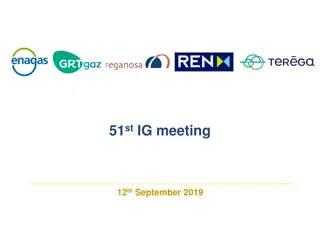
New Reporting Structure for Unrealized Revenue at Emory University Office for Clinical Research
Learn about the updated reporting structure for unrealized revenue at Emory University Office for Clinical Research, aimed at providing clearer financial reporting to the research community and improving customer satisfaction.
Download Presentation

Please find below an Image/Link to download the presentation.
The content on the website is provided AS IS for your information and personal use only. It may not be sold, licensed, or shared on other websites without obtaining consent from the author. If you encounter any issues during the download, it is possible that the publisher has removed the file from their server.
You are allowed to download the files provided on this website for personal or commercial use, subject to the condition that they are used lawfully. All files are the property of their respective owners.
The content on the website is provided AS IS for your information and personal use only. It may not be sold, licensed, or shared on other websites without obtaining consent from the author.
E N D
Presentation Transcript
NEW REPORTING STRUCTURE: UNREALIZED REVENUE Marcha Gatewood Charlie Stembridge Emory University Office for Clinical Research
TEAM MEMBERS Name Role Robin Ginn, RN, MBA, CHC, CHRC, CIP Asst VP, Resch Adm/Ex Dir, OCR, Office for Clinical Research Sherry Coleman, DNP, RN, CHRC Asc. Exec Dir, Clinical Trials, Office for Clinical Research Bridget Strong, MBA,CCRP Director, Education and Outreach (Project Liaison) Wenona Favors, MBA, CCRP Supervisor of Clinical Research Accounts (Advisor) Veronique King Supervisor of Clinical Research Accounts (Advisor) CRCAC committee members Survey response/feedback Research Administration Services (RAS) units Survey response/feedback
OCR: MISSION The mission of the Office for Clinical Research (OCR) is to facilitate operational processes that support the efforts of the clinical research team in the timely initiation, management and completion of clinical trials at Emory.
BACKGROUND The OCR Invoicing Team provides financial management services for Industry sponsored clinical trials to the entire School of Medicine. The Statement of Transactions (SOT) was initially created for OCR Invoicing internal reporting purposes only. Report may have been utilized in ways that negatively impact the study budget account. Lack of clarity and understanding have made it difficult to report outstanding funds to researchers and research administration departments. Unrealized revenue on report does not only consist of outstanding funds, but Total payments received, not itemized to the invoice(s) and/or patient activity. Total payments outstanding (Invoices and non-invoiceables). Withheld amounts per Clinical Trials Agreement. Emory University Office for Clinical Research
CURRENT (BASELINE) CONDITIONS Unrealized revenue on SOT report: Customers and Finance Managers frustrated due to lack of clarity. Emory University Office for Clinical Research
AIM STATEMENT To implement a new report that provides clear and improved financial reporting to the research community. Provide information that is useful to our customers/end users. Provide report in real time. To educate our customers on the use of the information provided on our report. Emory University Office for Clinical Research
GOAL Our Goal: new reporting structure/template. New report implemented and 100% of our customers educated by 9/1/19. Create an instant report that is accessible to the research community in real time. Benefit Improved customer satisfaction (measured by periodic surveys and face to face interviews). Emory University Office for Clinical Research
PROBLEM ANALYSIS Data requested from end users Clinical Research Advisory Committee and Research Administration Departments Survey containing 3 questions: 1. Please select the information you would like to see on the SOT. 2. How often would you like to receive the SOT? 3. If possible, would you like access to an online version of the SOT available in real-time? Emory University Office for Clinical Research
Q1: PLEASE SELECT THE INFORMATION YOU WOULD LIKE TO SEE ON THE SOT. Emory University Office for Clinical Research
Q2: HOW OFTEN WOULD YOU LIKE TO RECEIVE THE SOT? Emory University Office for Clinical Research
Q3: IF POSSIBLE, WOULD YOU LIKE ACCESS TO AN ONLINE VERSION OF THE SOT AVAILABLE IN REAL-TIME? Emory University Office for Clinical Research
Current Database 1. Study teams must rely on CRFMs to (re)generate the SOT report. System is outdated and not user friendly. Limited capabilities. Limited data volume. Outside vendor owned. Requires hours of overnight data back-up. All users share same password. Difficult to track Key Performance Indicators. 2. 3. 4. 5. 6. 7. 8. Emory University Office for Clinical Research
Future Database 1. User friendly. 2. Web based system. 3. Higher data volume. 4. Emory owned and operated. 5. Quick overnight data back-up. 6. Endless capabilities. 7. Individual passwords. 8. Easier tracking of Key Performance Indicators. Emory University Office for Clinical Research
METHODS: Technology: People: 1. Once a month reporting 2. Manual staff process 3. Variations in the use of report by customers 1. Limited Access Database 2. No real time reporting 3. Data retrieval cumbersome 1. Lack of training 2. Late reporting 3. Incorrect SOTs sent to customers Current SOTs contain information that can potentially have a negative impact on Clinical Trial Awards Materials: Measurement: Environment: 1. Sources Include Sponsors, Study teams, Research Administration Departments 1. Lack of customer satisfaction analysis 1. Lack of communication due to silo mentally 2. Limited room for error Emory University Office for Clinical Research
COUNTERMEASURES Action/Test of change Hopeful Outcome Implementing a new report that addresses customer needs. Improved customer satisfaction. Moving the invoicing database and reporting platform to a new system. Providing real time reports. Improved understanding of new report no frustration Educating the research community on analysis of new reports. Training for new and existing team members. Improved customer service to the research community. Sending periodic survey to assess understanding and customer satisfaction. Continuous improvement. Emory University Office for Clinical Research
FOLLOW UP/NEXT STEPS Implement new, improved report. Follow-up survey in September (and quarterly thereafter). Write Standard Operating Procedure to standardize process of generating reports in new system. Train end users and provide real time access to report. Educate study staff on implications of inaccurate tracking (with OCR education team). Emory University Office for Clinical Research
THANK YOU!!! CRCAC members (Survey responses) RAS teams (Survey responses) Dr. Nathan Spell III: Quality Academy Training OCR Leadership: Robin Ginn OCR invoicing: Sherry Coleman, Veronique King, Wenona Favors and entire team OCR education: Bridget Strong Emory University Office for Clinical Research

















